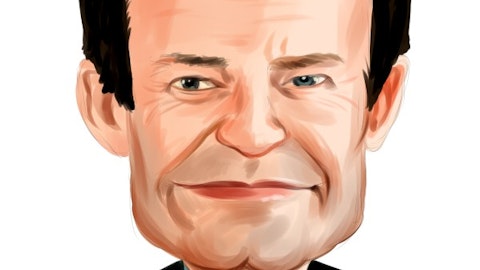So, we are optimistic.I think it’s probably, from the time we talked last quarter, the timeline has probably extended given some of the increased pressures that we’ve seen in return rate, kind of at those elevated levels.Also on a sequential basis, we saw a fuel tick up again. So it was kind of up 10% sequentially from just last quarter. We’re still lower on a year-over-year basis, but, you know, some of those things just work in our favor this quarter, but we feel optimistic over the mid to long term on that that line item.
Operator: Our next question comes from Alice Choy from Bank of America. Please go ahead. Your line is open.
Q – Alice Choy: Hi. Thanks for taking my question.Where do you see beauty shake out as a percentage of sales longer term? How quickly are you expanding that business, signing up new brands, what’s the crossover for customers that purchase apparel versus Beauty Now?How much lower is Beauty AOV what and what are long term margin implications if, you have a higher percentage of Beauty longer term.Just more details on Beauty would be helpful since it seems to be the one kind of category bright spot.
Michael Mente: Yeah. There’s other bright spot, but definitely Beauty is really, really shining.Long term wise, you know, we look at kind of historic competitors, you know, whether it be, you know, previous generation, kind of like legacy players, like the department stores, like, a noise from our Neiman’s and things like that and we triangulate, you know, call it 15%, some competitors receiving, higher or closer to 20%, but, ultimately, in a mature state, we think the business should be something in that zone. So we have a long way to go. Of course, over the long term, we anticipate kind of our core apparel business to continue to grow.So we think that, you know, from a dollar’s perspective, you know, you know, that 15% to 20% will hopefully just get larger and larger over time.So, moving target there.
So quite excited about that. You know, of course, it’s super obvious that our customers are buying clothes to go out. Of course, they’re wearing makeup and Beauty.So, of course, that natural fit there. Long term wise, when we look at the economics, just to tell you the best first in terms of talking about the puts and takes and the long term opportunity there.
Jesse Timmermans: Yeah sure and maybe just to corroborate, kind of something Michael mentioned, 15% plus or minus of our new customers came from Beauty. So it shows the potential of that mix increasing over time and some of that overlap that we do experience and then those Beauty customers do come back and purchase that higher AOVs over time, similar to our overall customer, but at a greater kind of increased AOV basis.So, opportunity to continue to sell across all those Beauty customers.From a kind of an economic standpoint, so gross margin is lower on those beauty products, but other things to keep in mind as we work down through the contribution margin, the return rate is significantly lower.So we’re talking, kind of mid-single digit return rate versus our overall return rate is much higher than that. So, you know, we think it’s a very healthy product category to have and balance out the mix there.
Operator: Our next question comes from Ashley Owens from KeyBanc Capital Markets. Please go ahead.Your line is open.
Ashley Owens: Great. Thanks for taking the question. Just would be curious to hear comments on the inventory mix within FWRD as it stands today. Are there any categories that you feel are close to being right sized? And then, inversely, any that you’re having a harder time clearing through that are creating some of those rebalancing lags. Thanks.
Mike Karanikolas: Yeah. So, you as a whole, we certainly have too much inventory.It is concentrated in brands that have more markdown restrictions that kind of prevent us from going, you know, through a normal kind of markdown cadence on the website itself and then from a category standpoint, it is concentrated in categories that tend to hold their value well, things like handbags, shoes, accessories, logoed products.So we feel good from that standpoint. But, it’s certainly been a challenging situation and a bit frustrating that the inventory still isn’t fully rebalanced but to Jesse’s earlier comments were hopeful in the coming quarter as well start to see that churn.
Operator: Our next question comes from Dylan Carden from William Blair. Please go ahead. Your line is open.
Dylan Carden: Thank you. I know you’re not going to give a hard numbers, but can you at least sort of somehow give us a sense of the dynamics on sort of the return number?Is it is it sort of increasing steadily quarter? Is it something that’s stabilizing just at a higher rate, just trying to get my hands around?
Mike Karanikolas: Yeah. I’m sure there’s a lot of moving parts every quarter, and we certainly break it down a number of different ways.So I couldn’t give you a conclusive answer on that, but I’d say directionally as we interpret the data, there was continued pressure in Q3, and it didn’t look like a stabilization in Q3. Now whether it was continued increasing kind of quarter-over-quarter rise is hard to say because there’s too many moving parts quarter by quarter in terms of mix shifts and other dynamics, but you know, we haven’t seen clear signs of stabilization.
Dylan Carden: Okay. And it’s something caught in passing in the prepared remarks. Is there a dynamic in the model now where if your sales come in higher than you expect, your earnings actually come in lower because they come with higher returns? Is there a dynamic that was at play in this quarter that I misunderstand?
Jesse Timmermans: No. I don’t think not necessarily.I think that a lot depending on the mix and, AOVs of course, but I would say,yeah. Not directly a result of net sales coming in.
Mike Karanikolas: I mean, in general, having net sales are good for everything including [Indiscernible]. Now, obviously, it depends on the dynamic, where marketing expenditures higher, where gross margins low and where return rates higher, but all things being equal.More net sales is a good thing.
Dylan Carden: Okay. Great. That’s all for me. Thanks.
Operator: Our next question comes from Simeon Siegel from BMO Capital Markets. Please go ahead. Your line is open.



